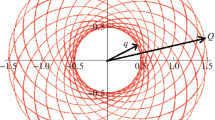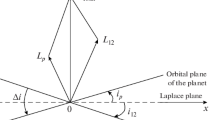Abstract
The problem of the secular evolution of a thin ring around a rapidly rotating triaxial celestial body is formulated and solved. The technology for calculating secular perturbations is based on two formulas: the azimuthally averaged force field of the central body and the mutual energy \({{W}_{{{\text{mut}}}}}\) of this body and a Gaussian ring. With \({{W}_{{{\text{mut}}}}}\) instead of the usual perturbing function, a system of differential equations for the osculating elements of the ring is obtained. An equation is obtained that allows one to find the coefficients of the zonal harmonics of the azimuthally averaged potential of an inhomogeneous ellipsoid using a unified scheme. The method is applied to dwarf planet Haumea with refined masses of the rocky core and the ice shell and the coefficients \({{C}_{{20}}}\) and \({{C}_{{40}}}\) of the po-tential’s zonal harmonics. According to new data, the ring around Haumea has a slight obliquity and must precess. It was established that the period of the retrograde nodal precession of the Haumea’s ring (without regard to self-gravity) is \({{T}_{\Omega }} = 12.9 \pm 0.7\) days and the period of the forward of the apside line precession is \({{T}_{\omega }} \approx 8.{\text{08}}\;{\text{days}}\). It is proven that the 3:1 orbital resonance for the particles of the Haumea’s ring is fulfilled only approximately and the averaging time of additional perturbations at a nonsharp resonance turned out to be an order of magnitude smaller than \({{T}_{\Omega }}\). This confirms the adequacy of the method.

Similar content being viewed by others
REFERENCES
D. Bérard, B. Sicardy, M. Assafin, F. Braga-Ribas, et al., in Proceedings of the 47th DPS Meeting, Washington, DC, U. S., Nov. 8–13,2015 (Am. Astron. Soc., 2015), id.104.02.
F. Braga-Ribas, B. Sicardy, J. L. Ortiz, et al., Nature (London, U.K.) 508, 72 (2014).
B. P. Kondratyev, Astrophys. Space Sci. 361, 169 (2016).
J. L. Ortiz, P. Santos-Sanz, B. Sicardy, et al., Nature (London, U.K.) 550, 219 (2017).
M. E. Brown, A. H. Bouchez, D. L. Rabinowitz, et al., Astrophys. J. Lett. 632, L45 (2005).
D. L. Rabinowitz, K. Barkume, M. E. Brown, et al., Astrophys. J. 639, 1238 (2006).
P. Lacerda, D. Jewitt, and N. Peixinho, Astron. J. 135, 1749 (2008).
M. E. Brown, M. A. van Dam, A. H. Bouchez, et al., Astrophys. J. 639, L43 (2006).
D. Ragozzine and M. E. Brown, Astron. J. 137, 4766 (2009).
B. P. Kondratyev and V. S. Kornoukhov, Mon. Not. R. Astron. Soc. 478, 3159 (2018).
B. P. Kondratyev, Solare Syst. Res. 46, 352 (2012).
V. A. Antonov, I. I. Nikiforov, and K. V. Kholshevnikov, Elements of the Theory of Gravitational Potential and Some Cases of its Explicit Expression (SPbGU, St. Petersburg, 2008) [in Russian].
B. P. Kondratyev and V. S. Kornoukhov, Tech. Phys. 64, 1395 (2019).
B. P. Kondratyev and V. S. Kornoukhov, Astron. Rep. 64, 434 (2020).
G. N. Duboshin, Celestial Mechanics. The Main Tasks and Methods (Nauka, Moscow, 1975) [in Russian].
B. P. Kondratyev, Theory of Potential. New Methods and Problems with Solutions (Mir, Moscow, 2007) [in Russian].
B. Sicardy, S. Renner, R. Leiva, F. Roques, M. El Mou-tamid, P. Santos-Sanz, and J. Desmars, in The Trans-Neptunian Solar System, Ed. by D. Prialnik, M. A. Barucci, and L. Young (Elsevier, Amsterdam, 2020), p. 249.
H. Alfven and G. Arrhenius, Evolution of the Solar System (Univ. Press of the Pacific, Honolulu, HI, 2004).
B. P. Kondratyev, Solar Sys. Res. 48, 396 (2014).
Author information
Authors and Affiliations
Corresponding author
Additional information
Translated by E. Chernokozhin
Rights and permissions
About this article
Cite this article
Kondratyev, B.P., Kornoukhov, V.S. Secular Evolution of Rings around Rotating Triaxial Gravitating Bodies. Astron. Rep. 64, 870–875 (2020). https://doi.org/10.1134/S1063772920100030
Received:
Revised:
Accepted:
Published:
Issue Date:
DOI: https://doi.org/10.1134/S1063772920100030




